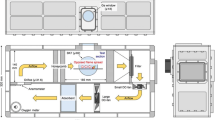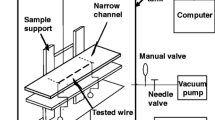Abstract
Combustion of electric wires is the most probable cause of fire in human space activities. Therefore, the fire performance of electric wires in microgravity conditions must be thoroughly analyzed. This study investigates the opposed-flow flame spread and its limits in electric wires preheated by external radiation, under both normal gravity and microgravity, to understand their fire performance when exposed to external heat sources in such gravity conditions. The experiments were performed on low-density polyethylene (LDPE)-insulated copper (Cu) wires having an outer diameter of 4 mm and differing in core diameter (2.5 and 0.7 mm, corresponding to insulation thicknesses of 0.75 and 1.65 mm, respectively). Both standard and black LDPE insulations were used to study the effect of radiation absorption on the wire preheating and subsequent flame spread. The comparison of the flame spread limits revealed that the wire with the thicker Cu core was less flammable under both normal gravity and microgravity; in particular, its flammability further decreased in the case of microgravity, in contrast with thinner electric wires (~ 1 mm outer diameter), which exhibited higher flammability in the same gravity condition. These results suggest that different mechanisms, for thicker and thinner wires, determining the critical conditions to sustain flame spread under microgravity. This study provides valuable information about the fire performance of electric wires in space gravity.










Similar content being viewed by others
References
Altenkirch RA, Tang L, Sacksteder K et al (1998) Inherently unsteady flame spread to extinction over thick fuels in microgravity. Symp Combust 27:2515–2524. https://doi.org/10.1016/S0082-0784(98)80103-3
Olson SL, Baum HR, Kashiwagi T (1998) Finger-like smoldering over thin cellulosic sheets in microgravity. Symp Combust 27:2525–2533. https://doi.org/10.1016/S0082-0784(98)80104-5
Olson SL, Ferkul PV (2017) Microgravity flammability boundary for PMMA rods in axial stagnation flow: experimental results and energy balance analyses. Combust Flame 180:217–229. https://doi.org/10.1016/j.combustflame.2017.03.001
Delichatsios MA, Altenkirch RA, Bundy MF et al (2000) Creeping flame spread along fuel cylinders in forced and natural flows and microgravity. Proc Combust Inst 28:2835–2842. https://doi.org/10.1016/S0082-0784(00)80706-7
Olson S., Kashiwagi T, Fujita O et al (2001) Experimental observations of spot radiative ignition and subsequent three-dimensional flame spread over thin cellulose fuels. Combust Flame 125:852–864. https://doi.org/10.1016/S0010-2180(00)00249-2
Nakamura Y, Kashiwagi T, Olson SL et al (2005) Two-sided ignition of a thin PMMA sheet in microgravity. Proc Combust Inst 30:2319–2325. https://doi.org/10.1016/j.proci.2004.07.037
Takahashi J, Fujita O, Ito K (2005) The effect of irradiation angle on laser ignition of cellulose sheet in microgravity. Proc Combust Inst 30:2311–2317. https://doi.org/10.1016/j.proci.2004.08.097
Bhattacharjee S, Wakai K, Takahashi S (2003) Predictions of a critical fuel thickness for flame extinction in a quiescent microgravity environment. Combust Flame 132:523–532. https://doi.org/10.1016/S0010-2180(02)00501-1
Bhattacharjee S, Ayala R, Wakai K, Takahashi S (2005) Opposed-flow flame spread in microgravity-theoretical prediction of spread rate and flammability map. Proc Combust Inst 30:2279–2286. https://doi.org/10.1016/j.proci.2004.08.020
Takahashi S, Ebisawa T, Bhattacharjee S, Ihara T (2015) Simplified model for predicting difference between flammability limits of a thin material in normal gravity and microgravity environments. Proc Combust Inst 35:2535–2543. https://doi.org/10.1016/j.proci.2014.07.017
Bhattacharjee S, Laue M, Carmignani L et al (2016) Opposed-flow flame spread: A comparison of microgravity and normal gravity experiments to establish the thermal regime. Fire Saf J 79:111–118. https://doi.org/10.1016/j.firesaf.2015.11.011
Bakhman NN, Aldabaev LI, Kondrikov BN, Filippov VA (1981) Burning of polymeric coatings on copper wires and glass threads: I. Flame propagation velocity. Combust Flame 41:17–34. https://doi.org/10.1016/0010-2180(81)90036-5
Bakhman NN, Aldabaev LI, Kondrikov BN, Filippov VA (1981) Burning of polymeric coatings on copper wires and glass threads: II. Critical conditions of burning. Combust Flame 41:35–43. https://doi.org/10.1016/0010-2180(81)90037-7
Kikuchi M, Fujita O, Ito K, et al (1998) Experimental study on flame spread over wire insulation in microgravity. Symp Combust 27:2507–2514. https://doi.org/10.1016/S0082-0784(98)80102-1
Miyamoto K, Huang X, Hashimoto N et al (2016) Limiting oxygen concentration (LOC) of burning polyethylene insulated wires under external radiation. Fire Saf J 86:32–40. https://doi.org/10.1016/j.firesaf.2016.09.004
Konno Y, Hashimoto N, Fujita O (2019) Downward flame spreading over electric wire under various oxygen concentrations. Proc Combust Inst 37:3817–3824. https://doi.org/10.1016/j.proci.2018.05.074
Fujita O, Kikuchi M, Ito K, Nishizawa K (2000) Effective mechanisms to determine flame spread rate over ethylene-tetrafluoroethylene wire insulation: discussion on dilution gas effect based on temperature measurements. Proc Combust Inst 28:2905–2911. https://doi.org/10.1016/S0082-0784(00)80715-8
Fujita O, Nishizawa K, Ito K (2002) Effect of low external flow on flame spread over polyethylene-insulated wire in microgravity. Proc Combust Inst 29:2545–2552. https://doi.org/10.1016/S1540-7489(02)80310-8
Nakamura Y, Yoshimura N, Matsumura T et al (2008) Opposed-wind effect on flame spread of electric wire in sub-atmospheric pressure. J Therm Sci Technol 3:430–441. https://doi.org/10.1299/jtst.3.430
Kobayashi Y, Konno Y, Huang X et al (2018) Effect of insulation melting and dripping on opposed flame spread over laboratory simulated electrical wires. Fire Saf J 95:1–10. https://doi.org/10.1016/j.firesaf.2017.10.006
Nakamura Y, Yoshimura N, Ito H et al (2009) Flame spread over electric wire in sub-atmospheric pressure. Proc Combust Inst 32:2559–2566. https://doi.org/10.1016/j.proci.2008.06.146
Huang X, Nakamura Y, Williams FA (2013) Ignition-to-spread transition of externally heated electrical wire. Proc Combust Inst 34:2505–2512. https://doi.org/10.1016/j.proci.2012.06.047
Osorio AF, Mizutani K, Fernandez-Pello C, Fujita O (2015) Microgravity flammability limits of ETFE insulated wires exposed to external radiation. Proc Combust Inst 35:2683–2689. https://doi.org/10.1016/j.proci.2014.09.003
Takahashi S, Ito H, Nakamura Y, Fujita O (2013) Extinction limits of spreading flames over wires in microgravity. Combust Flame 160:1900–1902. https://doi.org/10.1016/j.combustflame.2013.03.029
Mizutani K, Miyamoto K, Hashimoto N et al (2018) Limiting oxygen concentration trend of ETFE-insulated wires under microgravity. Int J Microgravity Sci Appl 35:350104. https://doi.org/10.15011//jasma.35.350104
Nagachi M, Mitsui F, Citerne J-M et al (2019) Can a spreading flame over electric wire insulation in concurrent flow achieve steady propagation in microgravity? Proc Combust Inst 37:4155–4162. https://doi.org/10.1016/j.proci.2018.05.007
Fujita O, Kyono T, Kido Y et al (2011) Ignition of electrical wire insulation with short-term excess electric current in microgravity. Proc Combust Inst 33:2617–2623. https://doi.org/10.1016/j.proci.2010.06.123
Takano Y, Fujita O, Shigeta N et al (2013) Ignition limits of short-term overloaded electric wires in microgravity. Proc Combust Inst 34:2665–2673. https://doi.org/10.1016/j.proci.2012.06.064
Shimizu K, Kikuchi M, Hashimoto N, Fujita O (2017) A numerical and experimental study of the ignition of insulated electric wire with long-term excess current supply under microgravity. Proc Combust Inst 36:3063–3071. https://doi.org/10.1016/j.proci.2016.06.134
Kim MK, Chung SH, Fujita O (2011) Effect of AC electric fields on flame spread over electrical wire. Proc Combust Inst 33:1145–1151. https://doi.org/10.1016/j.proci.2010.06.155
Lim SJ, Kim M, Park J et al (2015) Flame spread over electrical wire with AC electric fields: internal circulation, fuel vapor-jet, spread rate acceleration, and molten insulator dripping. Combust Flame 162:1167–1175. https://doi.org/10.1016/j.combustflame.2014.10.009
Lim SJ, Park SH, Park J et al (2017) Flame spread over inclined electrical wires with AC electric fields. Combust Flame 185:82–92. https://doi.org/10.1016/j.combustflame.2017.07.010
Citerne J-M, Dutilleul H, Kizawa K et al (2016) Fire safety in space: investigating flame spread interaction over wires. Acta Astronaut 126:500–509. https://doi.org/10.1016/j.actaastro.2015.12.021
Kashiwagi T (1975) A study of flame spread over a porous material under external radiation fluxes. Symp Combust 15:255–265. https://doi.org/10.1016/S0082-0784(75)80302-X
Quintiere J (1981) A simplified theory for generalizing results from a radiant panel rate of flame spread apparatus. Fire Mater 5:52–60. https://doi.org/10.1002/fam.810050204
Fernandez-Pello AC (1977) Downward flame spread under the influence of externally applied thermal radiation. Combust Sci Technol 17:1–9. https://doi.org/10.1080/00102209708946807
Fernandez-Pello AC (1977) Upward laminar flame spread under the influence of externally applied thermal radiation. Combust Sci Technol 17:87–98. https://doi.org/10.1080/00102207708946818
Kobayashi Y, Konno Y, Huang X et al (2019) Laser piloted ignition of electrical wire in microgravity. Proc Combust Inst 37:4211–4219. https://doi.org/10.1016/j.proci.2018.06.089
ISO4589-2 Plastics-determination of burning behaviour by oxygen index part 2: ambient temperature test
T’ien JS (1972) oscillatory burning of solid propellants including gas phase time lag. Combust Sci Technol 5:47–54. https://doi.org/10.1080/00102207208952502
Chan WY, T’ien JS (1978) An experiment on spontaneous flame oscillation prior to extinction. Combust Sci Technol 18:139–143. https://doi.org/10.1080/00102207808946845
Olson SL, Ferkul P V, Marcum JW (2019) High-speed video analysis of flame oscillations along a PMMA rod after stagnation region blowoff. Proc Combust Inst 37:1555–1562. https://doi.org/10.1016/j.proci.2018.05.080
Kumar A, Tien JS (2006) A computational study of low oxygen flammability limit for thick solid slabs. Combust Flame 146:366–378. https://doi.org/10.1016/j.combustflame.2006.02.008
Nakamura Y, Kizawa K, Mizuguchi S et al (2016) Experimental study on near-limiting burning behavior of thermoplastic materials with various thicknesses under candle-like burning configuration. Fire Technol 52:1107–1131. https://doi.org/10.1007/s10694-016-0567-5
Huang X, Link S, Rodriguez A et al (2019) Transition from opposed flame spread to fuel regression and blow off: effect of flow, atmosphere, and microgravity. Proc Combust Inst 37:4117–4126. https://doi.org/10.1016/j.proci.2018.06.022
Carmignani L, Bhattacharjee S (2019) Burn angle and its implications on flame spread rate, mass burning rate, and fuel temperature for downward flame spread over thin PMMA. Combust Sci Technol https://doi.org/10.1080/00102202.2019.1618286
Johnston MC, T’ien JS (2017) Gravimetric measurement of solid and liquid fuel burning rate near and at the low oxygen extinction limit. Fire Saf J 91:140–146. https://doi.org/10.1016/j.firesaf.2017.03.027
Guo F, Ozaki Y, Nishimura K et al (2019) Experimental study on flame stability limits of lithium ion battery electrolyte solvents with organophosphorus compounds addition using a candle-like wick combustion system. Combust Flame 207:63–70. https://doi.org/10.1016/J.COMBUSTFLAME.2019.05.019
Hu L, Zhang Y, Yoshioka K et al (2015) Flame spread over electric wire with high thermal conductivity metal core at different inclinations. Proc Combust Inst 35:2607–2614. https://doi.org/10.1016/j.proci.2014.05.059
Quintiere JG (2006) Fundamentals of fire phenomena. Wiley, Chichester
Hallman JR (1971) Ignition characteristics of plastics and rubber. The University of Oklahoma, Norman
Girods P, Bal H, Biteau H et al (2011) Comparison of pyrolysis behavior results between the cone calorimeter and the fire propagation apparatus heat sources. Fire Saf Sci 10:889–901. https://doi.org/10.3801/IAFSS.FSS.10-889
Bal N, Raynard J, Rein G et al (2013) Experimental study of radiative heat transfer in a translucent fuel sample exposed to different spectral sources. Int J Heat Mass Transf 61:742–748. https://doi.org/10.1016/j.ijheatmasstransfer.2013.02.017
Boulet P, Parent G, Acem Z et al (2014) Radiation emission from a heating coil or a halogen lamp on a semitransparent sample. Int J Therm Sci 77:223–232. https://doi.org/10.1016/j.ijthermalsci.2013.11.006
Boulet P, Gérardin J, Acem Z et al (2014) Optical and radiative properties of clear PMMA samples exposed to a radiant heat flux. Int J Therm Sci 82:1–8. https://doi.org/10.1016/j.ijthermalsci.2014.03.013
Kobayashi Y, Huang X, Nakaya S et al (2017) Flame spread over horizontal and vertical wires: the role of dripping and core. Fire Saf J 91:112–122. https://doi.org/10.1016/j.firesaf.2017.03.047
Olson SL (1991) Mechanisms of microgravity flame spread over a thin solid fuel: oxygen and opposed flow effects. Combust Sci Technol 76:233–249. https://doi.org/10.1080/00102209108951711
Huang X (2018) Critical drip size and blue flame shedding of dripping ignition in fire. Sci Rep 8:16528. https://doi.org/10.1038/s41598-018-34620-3
Wharton RK (1981) The effect of sample size on the burning behaviour of thermoplastic materials in the critical oxygen index test. Fire Mater 5:73–76. https://doi.org/10.1002/fam.810050207
Nakamura Y, Azumaya K, Iwakami J, Wakatsuki K (2015) Scale modeling of flame spread over PE-coated electric wires. In: Saito K, Ito A, Nakamura Y, Kuwana K (eds) Progress in scale modeling, vol II. Springer, Cham, pp 275–292
Acknowledgements
This research is supported by JAXA as a candidate experiment for the third stage use of JEM/ISS titled “Evaluation of gravity impact on combustion phenomenon of solid material toward higher fire safety” (called as “FLARE”).
Author information
Authors and Affiliations
Corresponding author
Additional information
Publisher's Note
Springer Nature remains neutral with regard to jurisdictional claims in published maps and institutional affiliations.
Rights and permissions
About this article
Cite this article
Konno, Y., Kobayashi, Y., Fernandez-Pello, C. et al. Opposed-Flow Flame Spread and Extinction in Electric Wires: The Effects of Gravity, External Radiant Heat Flux, and Wire Characteristics on Wire Flammability. Fire Technol 56, 131–148 (2020). https://doi.org/10.1007/s10694-019-00935-4
Received:
Accepted:
Published:
Issue Date:
DOI: https://doi.org/10.1007/s10694-019-00935-4




